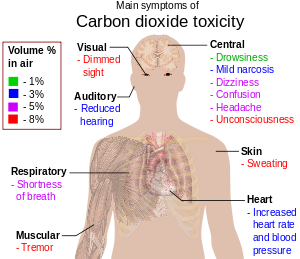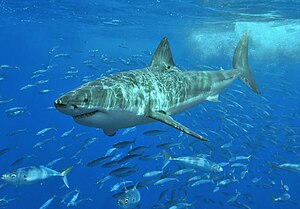 Image via Wikipedia
Image via Wikipedia
Despite the research, the experience, and all the data, I still hear “experts” – touting as wisdom – completely false information about cold water and what happens to people who get in it. With another season of really cold water approaching, I feel compelled to get these points across in a way that will change the way mariners behave out there on (or near) the water.
What follows is the truth about cold water and cold water immersion. I know that you think you know all there is to know about hypothermia already (and maybe you do), but read ahead and see if you aren’t surprised by something.
When the water is cold (say under 50 degrees F) there are significant physiological reactions that occur, in order, almost always.
You Can’t Breath:
The first is phase of cold water immersion is called the cold shock response: It is a stage of increased heart rate and blood pressure, uncontrolled gasping, and sometimes uncontrolled movement. Lasting anywhere from 30 seconds to a couple of minutes depending on a number of factors, the cold shock response can be deadly all by itself. In fact, of all the people who die in cold water, it is estimated that 20% die in the first two minutes. They drown, they panic, they take on water in that first uncontrolled gasp, if they have heart problems – the cold shock may trigger a heart attack. Surviving this stage is about getting your breathing under control, realizing that the stage will pass, and staying calm.
You Can’t Swim:
One of the primary reasons given by recreational boaters when asked why they don’t wear a life jacket, is that they can swim. Listen up, Tarzan; I swam for a living for the better part of my adult life, and when the water is cold – none of us can swim for very long. The second stage of cold water immersion is called cold incapacitation. lacking adequate insulation your body will make its own. Long before your core temperature drops a degree, the veins in your extremities (those things you swim with) will constrict, you will lose your ability control your hands, and the muscles in your arms and legs will just flat out quit working well enough to keep you above water. Without some form of flotation, and in not more than 30 minutes, the best swimmer among us will drown – definitely – no way around it. Without ever experiencing a drop in core temperature (at all) over 50% of the people who die in cold water, die from drowning perpetuated by cold incapacitation.
You Last Longer than You Think:
If you have ever heard the phrase, “That water is so cold, you will die from hypothermia within ten minutes.” then you have been lied to about hypothermia. For that matter you can replace ten minutes with twenty, or thirty, or even an hour, and you’ve still been lied to. In most cases, in water of say 40 degrees (all variables to one side), it typically takes a full hour to approach unconsciousness from hypothermia, the third stage of cold water immersion. But remember, you must be wearing flotation to get this far.
We are all different in this regard, but I once spent an hour in 44 degree water wearing street clothes and my core temperature was only down by less than two degrees (I was not clinically hypothermic). It was uncomfortable to be sure, and I wouldn’t recommend finding your own limit, but it probably would have taken another hour to lose consciousness, and an hour after that to cool my core to the point of no return. The bodies efforts to keep the core warm – vasoconstriction and shivering – are surprisingly effective. The shivering and blood shunting to the core are so effective, that twenty minutes after jumping in (twice the “you’ll be dead in ten minutes” time), I had a fever of 100.2.
Rescue Professionals Think You Live Longer:
There is a good side to the misconceptions about hypothermia. Should you ever be in the water in need of rescue, you can be certain that the Coast Guard is going to give you the benefit of every possible doubt. When developing search criteria – search and rescue coordinators use something called the Cold Exposure Survival Model (CESM): It is a program wherein they enter all the available data about the victim (age, weight, estimated body fat, clothing, etc.) and about the environment (water temp, sea state, air temp, wind) and the software spits them out a number that represents the longest possible time you can survive under those conditions. I plugged my own information into it once and it said I could survive for over 4 hours in 38 degree water wearing nothing but a t-shirt and jeans and no flotation. I can tell you from experience that the CESM is full of it – I’d give me 35 minutes tops – but the error is comforting. If the program that determines how long I might live is going to be wrong – I want it to be wrong in that direction.
Out of the Water is Not Out of Trouble:
I lost count of the number of survivors I annoyed in the back of the helicopter because I wouldn’t let them move. I had a rule – if they came from a cold water environment – they laid down and stayed down until the doctors in the E.R. said they could stand. It didn’t matter to me how good they felt or how warm they thought they were. Because the final killer of cold water immersion is post-rescue collapse. Hypothermia does things besides making everything colder. Victims are physiologically different for awhile. One of the things that changes is called heart-rate variability. The hearts ability to speed up and slow down has been effected. Getting up and moving around requires your heart to pump more blood, being upright and out of the water is also taxing, then any number of other factors collide and the heart starts to flutter instead of pump – and down you go. Victims of immersion hypothermia are two things; lucky to be alive, and fragile. Until everything is warmed back up – out of the water and dry is good enough – mobility comes later.
Did You Learn Anything?:
If you did, then hopefully you’ll use it to make good decisions when it comes to being safe on and around cold water; good decisions like these:
1. When working on deck, wear flotation. This includes, especially, all fisherman in Alaska. I couldn’t find more recent research, but the 31 Alaskan “fell overboard” casualties in 2005 died from drowning, not cold water. Not one of them was wearing flotation. Many couldn’t stay above water long enough for their own boats to make a turn and pick them up…..over a life jacket.
2. If you witness a man overboard – getting the life ring directly to them is critical (vital – step one – must do it). Make certain that all-important piece of safety gear is not just on your vessel, but readily available and not tied to the cradle.
3. When working on deck – wear flotation. I said that already? Well, when I quit reading search reports that end with “experienced” mariners dying because they thought they understood cold water – I’ll come up with better advice.
For more advice about how to handle an accidental immersion into cold water – please watch Cold Water Boot Camp below – it is one of the best 10 minutes on immersion hypothermia ever produced.
Thanks to gCaptain
Kathy Dowsett
www.kirkscubagear.com



















